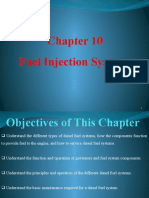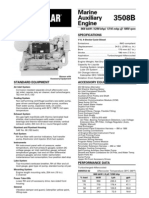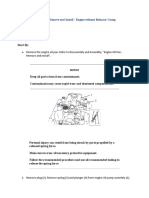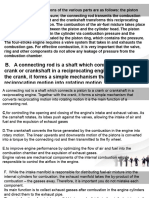Intake Air Management For Diesel Engines
Intake Air Management For Diesel Engines
Uploaded by
AshokCopyright:
Available Formats
Intake Air Management For Diesel Engines
Intake Air Management For Diesel Engines
Uploaded by
AshokOriginal Description:
Original Title
Copyright
Available Formats
Share this document
Did you find this document useful?
Is this content inappropriate?
Copyright:
Available Formats
Intake Air Management For Diesel Engines
Intake Air Management For Diesel Engines
Uploaded by
AshokCopyright:
Available Formats
Intake Air Management for Diesel Engines
Hannu Jskelinen, Magdi K. Khair
This is a preview of the paper, limited to some initial content. Full access requires DieselNet subscription. Please log in to view the complete version of this paper.
o o o o o o o o
Turbocharger Fundamentals Superchargers Dynamic Charging Charge Air Cooling Charge Air Heating Valves and Ports in Four-Stroke Engines Variable Valve Actuation (VVA) Scavenging in Two-Stroke Engines
Abstract: Managing the supply of air to the combustion chamber is an important process to ensure consistent and reliable performance of modern diesel engines. Air management encompasses all aspects that affect the quantity, composition, temperature, pressure, bulk motion and cleanliness of the combustion air at the start of the heat release period. Details of the intake system, cylinder head and valve train design, pressure boosting technology and charge dilution requirements are all important aspects of intake air management.
Introduction Volumetric Efficiency Pressure Charging Turbocompounding Intake Manifold Design
Introduction
Managing the supply of air to the combustion chamber is a critical aspect of modern diesel engines and can impact emissions, performance and fuel economy. Combustion air management is the process that is used to ensure that the air supplied to the combustion chamber at all operating conditions meets a number of requirements including:
a sufficient quantity of oxygen is available to ensure complete combustion, a sufficient amount of diluent (i.e., EGR) is present to control the combustion temperature, the temperature and pressure (density) of the charge air is controlled, suitable bulk motion and kinetic energy is imparted to the charge air in the cylinder to support the mixing of air, fuel and intermediate combustion products, and
the size and concentration of impurities such as dust and dirt is acceptable.
In older engine designs that did not have to meet stringent exhaust emissions requirements, air management systems could be relatively straightforward. In some cases, it was sufficient to simply ensure that the air was clean, that the flow capacity of the intake system was adequate to ensure peak torque and power objectives were met and sufficient swirl was imparted to the air as it entered the combustion chamber to support the fuel injection system in the task of mixing of air and fuel. Typically, no active control of any intake side hardware was required. Even as many engines started to adopt turbochargers and other forms of intake air compression, it was sufficient to simply ensure a proper match between the engine and compressor. Pressure to lower emissions while maintaining or improving other engine performance parameters required that the intake air properties be better controlled and matched to suit the engine operating condition. This required the introduction more hardware to control these intake air properties. For example, wastegate control on the turbocharger was introduced to enable improved intake air boosting at lower engine speeds and to limit turbine speeds at high engine speeds, valves were introduced to mix some exhaust gas (EGR) into the intake air at some engine operating conditions, turbocharger controls become more complicated to ensure that boost and EGR requirements could be met and higher and higher intake air pressures required that the higher intake air temperatures resulting from compression
be limited. All of this added complexity required that more sophisticated control systems with sensors and sophisticated control algorithms be incorporated to ensure everything functions as expected. This paper covers the basics of pressure chargingincluding turbochargers, superchargers and systems with multiple compressorsas well as turbocompounding and an introduction to intake manifold design. There are a number of additional important aspects of intake air management that will be discussed in separate papers. These include:
Charge Air Temperature Management. Managing the temperature of the air at the time of fuel injection in diesel engines is critical to ensure proper engine operation. There are two aspects of charge air temperature management:
o
managing high air temperature by cooling in boosted diesel engines and managing low air temperature by heating to facilitate engine start-up and warm-up at low ambient temperatures.
If temperatures are too high, charge density can suffer and combustion temperatures can become too high. This can limit engine output and lead to increased exhaust emissions. If temperatures are too low, starting the engine at low temperatures can be problematic and/or emissions during engine warm-up can become excessive. Various pieces of engine hardware are commonly used to achieve proper charge air temperature. In boosted engines, charge air coolers are used to keep charge air temperatures from becoming too high, these can transfer heat from the charge air to the engine coolant, the ambient air or a separate lower temperature liquid. Ensuring sufficient charge air temperature for cold starting and to maintain it during warm-up can be achieved with glow plugs, electric grid heaters or flame-type aids.
Exhaust Gas Recirculation. Exhaust gas recirculation (EGR), the process of recirculating some of the exhaust gas back into the intake
system, is an important technology that has allowed modern diesel engines to achieve very low engine out NOx emissions. As can be imagined, introducing relatively high temperature exhaust gas into the intake air can have significant impacts on the temperature and composition of the combustion air supplied to the combustion chamber. In order to ensure proper functioning of an engine with EGR, various hardware components, such as valves and coolers have to be introduced to control the flow, temperature and distribution of EGR supply and the resulting mixture with intake air. As well, turbocharger sizing and technology choices can also be affected and steps must be taken to ensure sufficient oxygen is still available for combustion and sufficient EGR flow is available at all engine operating conditions.
Crankcase Ventilation. Engines with closed crankcase ventilation systems vent gases from the crankcase into the intake air system to be recirculated into the engine. This recirculated blowby must be properly managed. Also, while the recirculated gases are filtered, a small amount of oil and particulate can still be introduced into the intake system and accumulate on critical air management components such as the compressor. Over time, if a sufficient accumulation of this material occurs, it can have a significant impact on the air management system performance.
Control of Flow into and out of the Combustion Chamber. From the intake manifold, the flow must be transferred to the cylinder. In four stroke engines, this is accomplished with a port located in the cylinder head with a poppet type valve to open and close the port. A different set of valve(s) controls the timing of the flow of exhaust gas out of the cylinder and into the exhaust port. Valve timing in four-stroke engines can be either fixed or variable. In two stroke engines, ports in the cylinder liner located near the pistons BDC location that are alternately covered and uncovered by the piston are commonly used to control intake flow. After combustion is complete, the burned gases from a two-stroke are expelled from the
cylinder either through exhaust valves or a different set of exhaust ports located near the pistons BDC position. The portion of the cycle available for expelling exhaust gases and admitting intake gases in two-strokes is relatively short. Generally, the intake gases must be pressurized in order to allow the incoming air to quickly fill the cylinder and scavenge it of exhaust gases.
Turbocharger Construction
A turbocharger consists of a compressor wheel and exhaust gas turbine wheel coupled together by a solid shaft and that is used to boost the intake air pressure of an internal combustion engine. The exhaust gas turbine extracts energy from the exhaust gas and uses it to drive the compressor and overcome friction. In most automotive-type applications, both the compressor and turbine wheel are of the radial flow type. Some applications, such as mediumand low- speed diesel engines, can use an axial flow turbine wheel instead of a radial flow turbine. The flow of gases through a typical turbocharger with radial flow compressor and turbine wheels is shown in Figure 1 [Schwitzer 1991].
Figure 1. Turbocharger Construction and Flow of Gases
Center-Housing. The turbine-compressor common shaft is supported by a bearing system in the center housing (bearing housing) located between the
compressor and turbine (Figure 2). The shaft wheel assembly (SWA) refers to the shaft with the compressor and turbine wheels attached, i.e., the rotating assembly. The center housing rotating assembly (CHRA) refers to SWA installed in the center-housing but without the compressor and turbine housings. The center housing is commonly cast from gray cast iron but aluminum can also be used in some applications. Seals help keep oil from passing through to the compressor and turbine. Turbochargers for high exhaust gas temperature applications, such a spark ignition engines, can also incorporate cooling passages in the center housing.
Figure 2. Sectional View of Turbocharger
Sectional view of an exhaust gas turbocharger for a gasoline engine showing compressor wheel (left) and turbine wheel (right). The bearing system consists of a thrust bearing and two fully floating journal bearings. Note the cooling passages. (Source: BorgWarner)
Turbocharger Bearings
Bearings. The turbocharger bearing system appears simple in design but it plays a key role in a number of critical functions. Some of the more important ones include: the control of radial and axial motion of the shaft and wheels and the minimization of friction losses in the bearing system. Bearing
systems have received considerable attention because of their influence on turbocharger friction and its impact on engine fuel efficiency. With the exception of some large turbochargers for low-speed engines, the bearings that support the shaft are usually located between the wheels in an overhung position. This flexible rotor design ensures that the turbocharger will operate above its first, and possibly second, critical speeds and can therefore be subject to rotor dynamic conditions such as whirl and synchronous vibration. Seals. Seals are located at both ends of the bearing housing. These seals represent a difficult design problem due to the need to keep frictional losses low, the relatively large movements of the shaft due to bearing clearance and adverse pressure gradients under some conditions. These seals primarily serve to keep intake air and exhaust gas out of the center housing. The pressures in the intake and exhaust systems are normally higher than in the turbochargers center housing which is typically at the pressure of the engine crankcase. As such, they would primarily be designed to seal the center housing when the pressure in the center housing is lower than in the intake and exhaust systems. These seals are not intended to be the primary means of preventing oil from escaping from the center housing into the exhaust and air systems. Oil is usually prevented from contacting these seals by other means such as oil deflectors and rotating flingers. Turbocharger seals are different from the soft lip seals normally found in rotating equipment operating at much lower speeds and temperatures. The piston ring type seal is one type that is often used. It consists of a metal ring, similar in appearance to a piston ring. The seal remains stationary when the shaft rotates. Labyrinth-type seals are another type sometimes used. Generally turbocharger shaft seals will not prevent oil leakage if the pressure differential reverses such that the pressure in the center housing is higher than in the intake or exhaust systems.
You might also like
- YC6A、6B、6J yuchai engine manual bookDocument99 pagesYC6A、6B、6J yuchai engine manual bookasim ghoshNo ratings yet
- Material and Energy Flows in RKEFDocument18 pagesMaterial and Energy Flows in RKEFKen FabeNo ratings yet
- General Tolerances DIN ISO 2768Document2 pagesGeneral Tolerances DIN ISO 2768Vasil Gospodinov79% (24)
- 25 Best Short Animal Stories For Kids With MoralsDocument23 pages25 Best Short Animal Stories For Kids With MoralsAshok75% (8)
- Engine Design ClassificationDocument76 pagesEngine Design ClassificationLuis NunesNo ratings yet
- Flaktwoods Plate FanDocument27 pagesFlaktwoods Plate FanEldin JelecNo ratings yet
- D2842 Heavy DutyDocument4 pagesD2842 Heavy Dutym_najman100% (2)
- Ed 7002 Efm NotesDocument58 pagesEd 7002 Efm NotesAshokNo ratings yet
- Silicone Molding For Product Design: White PaperDocument19 pagesSilicone Molding For Product Design: White PaperDarren DeVoseNo ratings yet
- Twin-Scroll TurbochargerDocument24 pagesTwin-Scroll TurbochargerJih Yan LaiNo ratings yet
- Turbochargers in Diesel EnginesDocument5 pagesTurbochargers in Diesel Enginesmister_no34No ratings yet
- ABB Turbocharging VTC PDFDocument8 pagesABB Turbocharging VTC PDFhanifNo ratings yet
- TurbochargerDocument21 pagesTurbochargerJo VialNo ratings yet
- Types of Scavenging: Loop or Cross Scavenge UniflowDocument22 pagesTypes of Scavenging: Loop or Cross Scavenge UniflowBharatiyulamNo ratings yet
- Gilkes Self PrimingDocument12 pagesGilkes Self Priming2009tamerNo ratings yet
- Turbocharger System 612.01: Description Page 1 (2) Edition 22HDocument7 pagesTurbocharger System 612.01: Description Page 1 (2) Edition 22HwilsonNo ratings yet
- Understanding Model Name of Turbo Garret G Series - WWW - Magyarturbo.huDocument12 pagesUnderstanding Model Name of Turbo Garret G Series - WWW - Magyarturbo.huAnprtmk072100% (1)
- Owners Handbook BUKH U125Document79 pagesOwners Handbook BUKH U125Alexandros KontosNo ratings yet
- Chapter 10Document78 pagesChapter 10Si Thu AungNo ratings yet
- 02 - Alternator (1DB 1036-8AY05-Z)Document521 pages02 - Alternator (1DB 1036-8AY05-Z)Raymond TjsNo ratings yet
- Mi 1719Document13 pagesMi 1719amir barekatiNo ratings yet
- Engine Performance Optimization - GT PowerDocument2 pagesEngine Performance Optimization - GT Powermanoj262400/2No ratings yet
- 12V Cummins Torque Specs PDFDocument8 pages12V Cummins Torque Specs PDF180976No ratings yet
- Alco Injection SystemDocument25 pagesAlco Injection SystemAniket KshirsagarNo ratings yet
- Bwts Library 530 623Document27 pagesBwts Library 530 623Tri Minh100% (1)
- Injection SystemDocument75 pagesInjection SystemSlobodan100% (1)
- Yanmar Engine Type 6CXM-GTE2Document2 pagesYanmar Engine Type 6CXM-GTE2Yoga_DMNo ratings yet
- Combustion in Si EngineDocument20 pagesCombustion in Si EngineAliza BalochNo ratings yet
- Fuel Injection Distributor Fuel Injection SystemDocument1 pageFuel Injection Distributor Fuel Injection SystemSaptarshi BasuNo ratings yet
- Diesel Fuel SystemDocument36 pagesDiesel Fuel SystemFeckry Ag Ghani100% (1)
- PDFDocument59 pagesPDFEldin SalihbasicNo ratings yet
- Technical Specification - Rev - 2 July14Document21 pagesTechnical Specification - Rev - 2 July14مراد احمدNo ratings yet
- Hino H07C H07CT H07D H07DT H07E H07ET Engine Specifications IIDocument14 pagesHino H07C H07CT H07D H07DT H07E H07ET Engine Specifications IIitalianstallion69chickmagnetNo ratings yet
- Cylinder-Head Gaskets: Good ExperienceDocument18 pagesCylinder-Head Gaskets: Good ExperienceAgus MulyanaNo ratings yet
- Fuel Injection System of Diesel EngineDocument15 pagesFuel Injection System of Diesel Enginegurudatt.kulkarni100% (2)
- BorgWarner 2015 CatalogDocument84 pagesBorgWarner 2015 CatalogMarius Baciu100% (2)
- Wankel EngineDocument15 pagesWankel EngineMuhammad Bin RiazNo ratings yet
- Variable Geometry Turbocharger Technologies For Exhaust Energy Recovery and Boosting A ReviewDocument17 pagesVariable Geometry Turbocharger Technologies For Exhaust Energy Recovery and Boosting A ReviewMomen Al-Himony100% (1)
- 140 Series O&M ManualDocument48 pages140 Series O&M ManualhassanHyro4350% (2)
- Reciprocating Engine Fuel Metering PT2Document33 pagesReciprocating Engine Fuel Metering PT2Alyssa DelatorreNo ratings yet
- Exhaust Manifold DesignDocument30 pagesExhaust Manifold DesignSandeep Kr. MishraNo ratings yet
- Fuel Injector Reference For 3500Document9 pagesFuel Injector Reference For 3500ingcalderonNo ratings yet
- Crankshaft TerminologyDocument16 pagesCrankshaft TerminologySathistrnpcNo ratings yet
- ROJ-DOC-Report On Fuel Injection Equipment PDFDocument37 pagesROJ-DOC-Report On Fuel Injection Equipment PDFNitin Sakpal0% (1)
- Vidya Vardhaka College of Engineering Mysuru: "Diesel Particulate Filter"Document15 pagesVidya Vardhaka College of Engineering Mysuru: "Diesel Particulate Filter"dhanalakshmi k sNo ratings yet
- QuickServe Online - (3666087) B3.9, B4.5, B4.5 RGT, and B5.9 Service ManualDocument20 pagesQuickServe Online - (3666087) B3.9, B4.5, B4.5 RGT, and B5.9 Service ManualArief FadillaNo ratings yet
- Injector Adjust - PDFDocument2 pagesInjector Adjust - PDFMusaferNo ratings yet
- Student's MdedhDocument86 pagesStudent's MdedhthomasdilirionNo ratings yet
- Cat-3508b - DSDocument2 pagesCat-3508b - DSfwklNo ratings yet
- PVEO12Document30 pagesPVEO12Elvin DomingoNo ratings yet
- Crankshaft Speed MeasurementsDocument70 pagesCrankshaft Speed MeasurementsJefersonNo ratings yet
- Fuel Injectors ModifiedDocument10 pagesFuel Injectors ModifiedSarath ChandraNo ratings yet
- Turbo Charger PresentationDocument22 pagesTurbo Charger PresentationPragyan Kumar0% (1)
- NAVEDTRA 14050A Construction Mechanic Advanced Part 3 PDFDocument160 pagesNAVEDTRA 14050A Construction Mechanic Advanced Part 3 PDFSon Do100% (1)
- Details of FipDocument13 pagesDetails of FipSRIKANTH GDNo ratings yet
- Diesel EnginesDocument15 pagesDiesel EnginesDivyansh kaushalNo ratings yet
- Install Oil PumpDocument4 pagesInstall Oil PumpbagoesNo ratings yet
- MBH Conversion References - Deutz-MWM TBD 6M 628Document1 pageMBH Conversion References - Deutz-MWM TBD 6M 628Marbun Benny100% (1)
- R1A4016R B12A1H1A A: Q Series PumpsDocument40 pagesR1A4016R B12A1H1A A: Q Series Pumpseaglego00No ratings yet
- Engine TestDocument20 pagesEngine TestTUMELONo ratings yet
- Engine Intake Charge ManagementDocument4 pagesEngine Intake Charge ManagementSirleh SalehNo ratings yet
- AtlawDocument9 pagesAtlawAtlaw Son Atlaw GisheNo ratings yet
- The New Mercedes-Benz 4.0 L V8 Diesel EngineDocument4 pagesThe New Mercedes-Benz 4.0 L V8 Diesel EngineEichi WatanabeNo ratings yet
- Basic Tools 1Document13 pagesBasic Tools 1Kannan Nehru100% (1)
- NASA Fastener Design ManualDocument100 pagesNASA Fastener Design ManualAaron D. MillerNo ratings yet
- Basic Hydro Dynamic DriveDocument68 pagesBasic Hydro Dynamic DriveAshokNo ratings yet
- Transfer CaseDocument41 pagesTransfer CaseAshok67% (3)
- Combustion Chamber Sae-Ref PaperDocument9 pagesCombustion Chamber Sae-Ref PaperAshokNo ratings yet
- Synchro RingDocument9 pagesSynchro RingAshokNo ratings yet
- Basics of SynchronizersDocument78 pagesBasics of SynchronizersAnish PaiNo ratings yet
- Eaton Trnsmission Service ManualDocument140 pagesEaton Trnsmission Service ManualAshokNo ratings yet
- Gravimetric MilliporeTestingDocument7 pagesGravimetric MilliporeTestingAshokNo ratings yet
- ThreadDocument334 pagesThreadAshokNo ratings yet
- Geometric Dimensioning and TolerancingDocument4 pagesGeometric Dimensioning and TolerancingAshokNo ratings yet
- Applied Mechanics by RK RajputDocument408 pagesApplied Mechanics by RK Rajputsarthak100% (2)
- Stress Analysis and Design Optimization of CrankpinDocument3 pagesStress Analysis and Design Optimization of CrankpinAshokNo ratings yet
- Aluminium Alloy 2014A T651 Sheet and Plate: Specifications Temper TypesDocument3 pagesAluminium Alloy 2014A T651 Sheet and Plate: Specifications Temper TypesBeni hidayatullahNo ratings yet
- Carbohydrate MetabolismDocument30 pagesCarbohydrate MetabolismHafsahNo ratings yet
- -Document5 pages-Tooba SardarNo ratings yet
- Chapter 5 ProtectionDocument59 pagesChapter 5 Protectionshenouda403No ratings yet
- Employing The Taguchi Method To Obtain The Optimum Conditions of Coagulation - Occulation Process in Tannery Wastewater TreatmentDocument8 pagesEmploying The Taguchi Method To Obtain The Optimum Conditions of Coagulation - Occulation Process in Tannery Wastewater TreatmentfonsynickNo ratings yet
- Questionpaper Paper1C January2015 PDFDocument36 pagesQuestionpaper Paper1C January2015 PDFChahinese FahsiNo ratings yet
- Bza8050 Data SheetDocument4 pagesBza8050 Data SheetseagatNo ratings yet
- Cea 4010Document11 pagesCea 4010Troi LauraNo ratings yet
- Compozitie MaterialeDocument25 pagesCompozitie MaterialeGross Meltiade AlexanderNo ratings yet
- Classification of Org. CompdDocument7 pagesClassification of Org. CompdRaju SinghNo ratings yet
- The Particulate Nature of Matter 1 QPDocument10 pagesThe Particulate Nature of Matter 1 QPKHANNo ratings yet
- Solid Cast Versus Resin Encpsulated TrafoDocument5 pagesSolid Cast Versus Resin Encpsulated TrafoGuruprasad NagarajasastryNo ratings yet
- EXTRACTIVEDocument34 pagesEXTRACTIVEraj mehra100% (2)
- BPHARM 202 Pharmacognosy 2019-2020 SessionDocument105 pagesBPHARM 202 Pharmacognosy 2019-2020 SessionYusuf UmarNo ratings yet
- Detective DyesDocument22 pagesDetective DyesDisha bhardwajNo ratings yet
- Cold Drawn PDFDocument1 pageCold Drawn PDFAna Emily PrentissNo ratings yet
- Glass Transition TemperatureDocument5 pagesGlass Transition TemperatureAndrek QueckNo ratings yet
- Astm C 642 90 Calidad Del ConcretoDocument3 pagesAstm C 642 90 Calidad Del ConcretoBayron Medina Ospina0% (1)
- ATURIA Submersible 3ante WEBDocument6 pagesATURIA Submersible 3ante WEBEileen TylerNo ratings yet
- Chapter 4: Imperfections in Solids: Issues To Address..Document34 pagesChapter 4: Imperfections in Solids: Issues To Address..usercmdmcNo ratings yet
- Techfinix PVT LTDDocument28 pagesTechfinix PVT LTDshrikant_pesitNo ratings yet
- Global Oilfield Solutions: Performance Chemicals For ProductionDocument6 pagesGlobal Oilfield Solutions: Performance Chemicals For ProductionLê CôngNo ratings yet
- Alcohol Ether PhenolDocument80 pagesAlcohol Ether PhenolMAJR 104100% (1)
- Linx 1240 MSDSDocument5 pagesLinx 1240 MSDSOussama HAMENNICHENo ratings yet
- NSEB Solved PaperDocument15 pagesNSEB Solved Papershruti.fedbankNo ratings yet
- Arc Blow LogoDocument3 pagesArc Blow Logoأحمد حسنNo ratings yet
- One Pot Successive Turbo Grignard ReactionsDocument8 pagesOne Pot Successive Turbo Grignard Reactionss adhikariNo ratings yet
- May 2021 .Document22 pagesMay 2021 .Innocent DimpleNo ratings yet









































































































